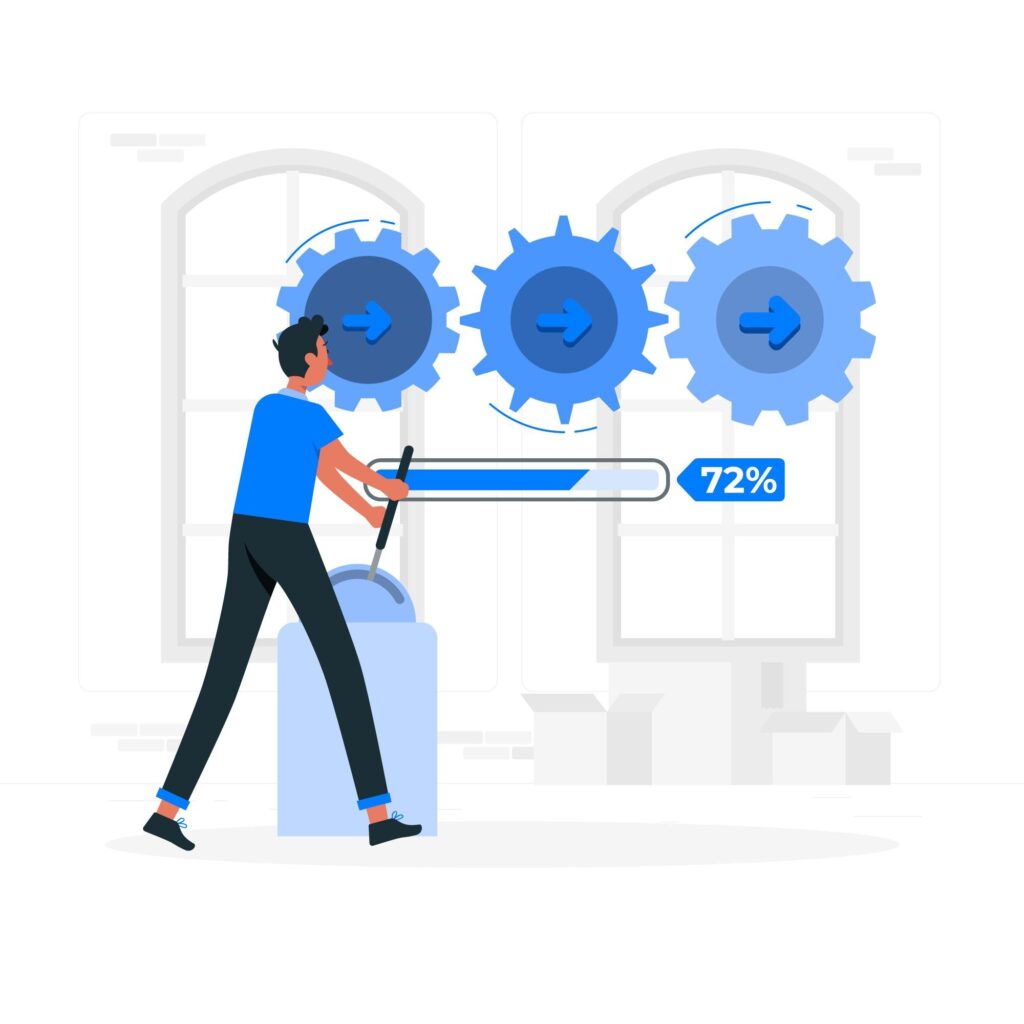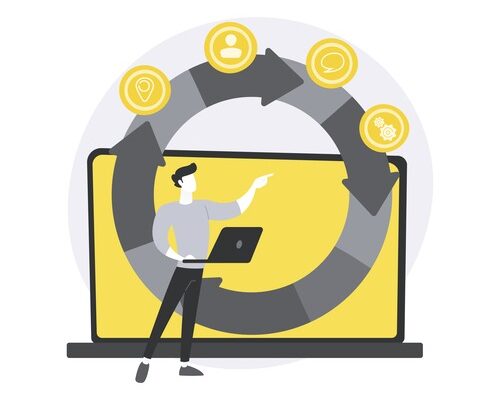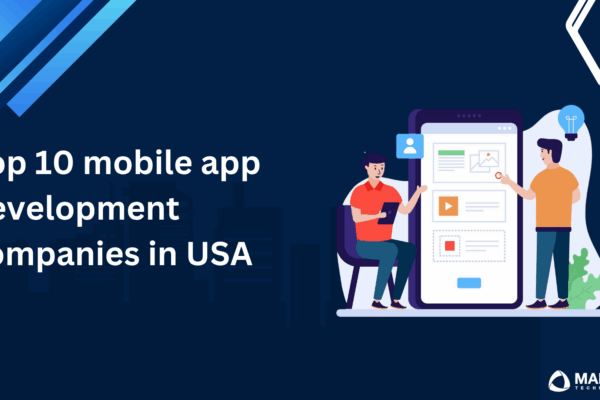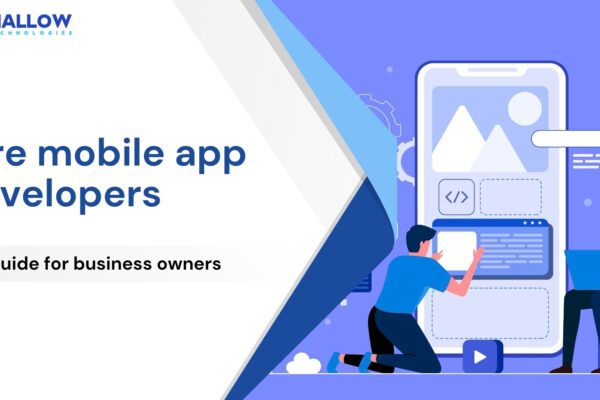Have you recently delved into information about Mallow? Have you taken the step to fill out the form to kickstart a conversation with our expert? We understand that reaching this stage in the shortlisting process may have involved overcoming various challenges. However, your questions and uncertainties are unlikely to fade at this point.
We are dedicated to leaving no questions unanswered and committed to aiding you in making an informed decision as you contemplate the prospect of partnering with us. Through this article, our goal is to offer insights into what you can expect throughout your collaboration with Mallow for the development of a mobile application.
As a committed custom software development company, Mallow acknowledges that successful collaboration is built on the foundations of transparency and communication. The team’s expertise in crafting mobile applications across diverse domains with substantial user bases has proven to be a significant advantage for our clients. This proficiency ensures that our clients benefit from a wealth of experience and insights, leading to the development of highly effective and user-friendly mobile applications tailored to specific industries and audiences.
Upon reading this article, you will gain a thorough understanding of what it means to engage in a mobile project enriched with Mallow’s distinctive touch. Through our client-centric approach, we have meticulously crafted a comprehensive roadmap, guiding you through every stage of mobile application development. This ensures you have a front-row seat to a well-defined and transparent process.
What does the setup process in the initial phase entail?

From the initial spark of the discovery call to the commencement of project execution, every stage is pivotal. Here are the steps encompassed in the project setup’s initial phase.
1. The discovery call (duration – 1 day)
The journey into the mobile application development process with Mallow commences with a pivotal discovery call. This phase serves as the foundation for the project. During this interactive session, our team will engage with you to grasp your vision, objectives, and expectations. This open dialogue aids in aligning the development approach with your aspirations, ensuring a clear understanding of the project’s scope, goals, and challenges. By the end of the discovery call, we both will share a unified perspective, setting the stage for a collaborative and informed development journey.
Regardless of who the mobile application development team is, it is crucial to prepare for the discovery call by understanding the essential aspects of the project. By taking the time to prepare for the discovery call, you can ensure that it is a productive and successful experience for everyone involved. Refer to the checklist provided in the article before your discovery call, about choosing the right application development team. This checklist will be your go-to guide during the discovery call, ensuring you derive maximum value from the interaction.
2. Defining your application development team (duration 1-2 days)
The composition and scale of your mobile application development team are directly linked to the specific services you intend to engage with Mallow. The nature of your project, whether it involves creating a sleek mobile app, a robust web platform, or a complex enterprise solution, will influence the expertise and skill sets required.
The team size may range from a compact, agile group for smaller projects to a multidisciplinary ensemble for more extensive ventures. This includes services such as design, development, quality assurance, and project management, which will determine the roles and specialisation within the team. Aligning the scope of your mobile application project with the appropriate team configuration is crucial in ensuring a seamless and successful collaboration with Mallow.
For example, let us consider a mobile application with around 8-10 modules, each module having 7 to 8 features. The application also needs a few third-party integrations, handling a sizable amount of data and being used by various users. It is essential to hire the right amount of team members from different services to manage the features delivered within the timeline.
The table below will give you an overview of some possible roles you could consider hiring.
| Roles | Responsibilities |
| Project Manager | Responsible for defining project goals. Ensures alignment with business objectives throughout the development process |
| Business Analyst | Works closely with stakeholders to gather requirements. Analyses business requirements.Translates them into functional specifications for the development team |
| Technical Manager | Ensures the successful delivery of the application. Build platform strategies to achieve customer business goals. Identify business risks and technical solutions to mitigate them. Collaborate with the team members on technical and customer service challenges. Evaluate existing client data/architectural models and perform/drive in-depth analysis of systems, data flow processes, and architectural setup |
| Designer | Analyses the customer needs and implements the same in prototypingIdeation of designs. Execution of proper theme and colorations as per the expectations. Works on implementing user interface. Ensures the way of presentation is compatible enough |
| Back-end developer(s) | Develops the server-side components. Handles data management.Implements business logic. Integrates various systems to ensure the application’s functionality and performance. |
| Front-end developer(s) | Implements the user interface and interactive components of the application using web technologies such as HTML, CSS, and JavaScript, React and Angular. Ensures an engaging and user-friendly experience. |
| DevOps | Coordinates with project managers for architecture planning. Create scripts to automate deployments.Setting up CI/CD Deploys updates. Adheres to proper security measures in the production workloads. Analyses the root cause for hosting-related errors in production. Does risk analysis of the application. Audits the project architecture and suggests the best practices. Monitors the health of the application. Implements procedures to tackle system troubleshooting and maintenance. Ensures the application meets the current industry standards. |
| Quality Analyst | Ensures the quality of the software delivered. Develops and executes plans for testingImplements and monitors test scripts and monitors reliability and performance. Monitors and recommends preventive measures. Suggests corrective actions. Investigates customer complaints and product issues. Drafts quality assurance policy and procedures |
| Team Lead | Mentor and lead development teams in the implementation of solutions. Technically manages the team, audits the code, and assures product quality. Define the solution roadmap, as well as the requirements and use cases that will be used to drive implementation plans and estimates. |
Please note that the roles mentioned above represent potential contributors within an application development team, but the optimal combination of services and team members must be tailored to align precisely with the unique demands of your project.
3. Signing contracts (duration – 1 day)
Contracts are the legal foundation of a collaborative partnership. This stage, lasting a day, involves formalising the agreement between you and team Mallow. The contract outlines deliverables, timelines, terms of engagement (including pricing details, team size, services opted and the notice period), and confidentiality agreements. This essential step ensures clarity and transparency, establishing a framework for mutual understanding and accountability.
4. Defining the ideal project management model for your application (duration – 1 day)
With requirements crystallised, Mallow spends a day defining the project management model. This step establishes the roadmap for project execution, encompassing timelines, milestones, communication protocols, and workflow strategies. By crafting a robust project management model, we ensure seamless coordination, transparent reporting, and efficient resource allocation throughout the development lifecycle.
Establishing the appropriate project management model for your application is very crucial as that demands careful consideration. Explore this article on selecting the right project management model to effectively navigate the process of choosing the right approach for your project’s management.
5. Setting up your project (duration – 1 to 2 days)
The start of the project is the most exciting part, especially when everyone has put in their input and ideas to make it a collaborative and informed kick-off. Over 1 to 2 days, the development team begins actualising the project plan. This entails setting up development environments, establishing communication channels, and aligning resources. With a shared vision, comprehensive requirements, and a solid team in place, the project enters its active execution phase, marking the commencement of turning ideas into reality.
The below-mentioned table below will give you an idea of what the nature of the tasks during this phase will look like when you are planning to develop either a new application or enhance your existing application.
| Tasks | If you are planning for a new application | If you own an existing application |
| Set up development environments | Configure development tools and frameworks for building the application. Prepare version control systems and establish coding standards. | Assess the existing development environment. Update and align tools, frameworks, and coding standards as necessary. |
| Establishing communication channels | Set up collaborative platforms and communication tools for the team. Define communication protocols and establish regular meetings. | Review and enhance communication channels. Ensure ongoing collaboration with developers, designers, and stakeholders. |
| Aligning resources | Assign roles and responsibilities within the development team. Ensure a mix of developers, designers, QA specialists, and a project manager. | Reassess team roles and responsibilities. Allocate resources based on new tasks, updates, and any changes to the development team structure. |
| Verifying shared vision | Confirm that the entire team understands the project’s objectives and goals. Address any questions or concerns regarding the project. | Revisit the initial vision of the application. Align the vision with any shifts in business goals, user needs, or industry trends. |
| Adapting comprehensive requirements | Ensure the team has a clear understanding of the application’s functionalities. Refine user stories, features, and technical specifications. | Review and refine existing application features. Consider enhancements, bug fixes, and updates based on user feedback and evolving business needs. |
| Transitioning to the active execution phase | Initiate coding, designing, and testing processes as per the project plan. Develop the first iteration or Minimum Viable Product (MVP) for testing. | Seamlessly integrate new tasks into the ongoing development workflow. Prioritise updates, bug fixes, and feature enhancements based on business priorities. |
What does the application development cycle look like?

As a leading custom software development company, Mallow follows a meticulously crafted application development cycle that ensures the creation of robust, innovative, and user-centric software solutions. This comprehensive approach guides the journey from conception to deployment, encompassing a series of interconnected stages that leverage cutting-edge technologies, efficient processes, and collaborative expertise.
1. Finalising the application’s requirement
During this phase, team Mallow will analyse your requirements. This comprehensive evaluation delves deep into the intricacies of the project, encompassing its functional, technical, and design aspects.
Your active engagement is crucial during the requirement finalisation process. This involves thorough back-and-forth confirmations to ensure no aspect is overlooked in shaping the application precisely according to your needs. The outcome is a comprehensive project brief outlining the blueprint, functionalities, user experiences, and technical specifications. This stage facilitates an in-depth understanding of your needs and lays the groundwork for informed decision-making.
This phase includes tasks such as:
✅ Understanding your business goals
✅ Defining, prioritising and documenting the requirements of the scope
✅ Validating requirements received
✅ Prototyping or mockups
✅ Legal and compliance
✅ Data Management, performance and scalability
✅ Security and privacy
✅ Localisation and internationalisation
✅ Review and approval
✅ Documentation repository
Please note that The typical timeframe for requirement analysis varies from a few days to several weeks based on the project’s specifics. The exact duration is contingent upon the unique nature of each project undertaken by the Mallow development team.
2. Planning and strategy
Once requirements are established, the planning and strategy stage comes into play. We craft the project plan that outlines timelines, milestones, allocation of resources to the designated tasks in the project, and risk management strategies. This plan serves as a roadmap, guiding the development process and ensuring efficient execution. The team establishes communication protocols, sets up project management tools, and defines roles and responsibilities, projecting a collaborative environment that ensures smooth progress.
| Key components of the planning stage | |
| Aspect | Description |
| Timeline | Establish a project timeline with key milestones and deadlines |
| Resource Allocation | Allocate roles, responsibilities, and needed skill sets |
| Task Breakdown | Divide the project into smaller tasks and subtasks |
| Risk Assessment | Identify potential risks and plan for mitigation |
| Communication Plan | Define communication channels and reporting structures |
3. Design and prototyping
In the design and prototyping stage, our designers create interactive prototypes that offer a tangible representation of the application’s user interface and experience. This prototyping phase allows clients and stakeholders to visualise the software’s functionality and flow, enabling informed feedback and design refinements. By integrating user-centric design principles, Mallow ensures that the application meets and exceeds user expectations.
4. Development and coding
With the blueprint in hand, the development and coding stage comes to the forefront. Mallow’s proficient developers transform concepts into code and build the backend and frontend components of the application. Adhering to industry best practices and leveraging the latest technologies, the team builds a robust and scalable foundation that forms the core of the software solution.
What does the development and coding phase of Mallow look like?
- Sprint planning
Before each sprint, Mallow’s development team conducts sprint planning sessions. They break down the project into user stories or tasks, estimate the effort required, and prioritise them based on business value and complexity. - Coding and development
Mallow’s skilled developers begin writing the code based on the requirements and user stories outlined in the sprint. We diligently formulate comprehensive unit test cases to ensure the robustness and functionality of our codebase. - Version control and collaboration
Mallow uses version control systems like Git to manage the codebase. This enables seamless collaboration among developers, facilitates code reviews, and provides a history of changes made to the codebase. - Continuous integration and continuous deployment (CI/CD)
Mallow emphasises CI/CD practices to automate the testing, building, and deployment of the application. Automated tests are run regularly to ensure that new code changes don’t impact the existing flow of the application. - Code reviews
Code reviews are a vital part of Mallow’s development process. Developers review each other’s code to identify bugs, ensure adherence to coding standards, optimise the code and share knowledge. This practice of peer review promotes code quality and knowledge sharing. - Unit and Integration Testing
Mallow’s development team writes unit tests to verify the functionality of individual components and integration tests to test the interactions between different modules. These tests help catch bugs early in the development process.
5. Quality assurance
Mallow’s commitment to quality in the thorough Quality Assurance and Testing phase. The application undergoes rigorous testing to identify and rectify any potential bugs, glitches, or performance issues. Mallow’s QA specialists conduct various types of testing, including functional, performance, security, and usability testing, ensuring that the application not only works flawlessly but also offers a seamless and secure user experience.
Just to give you an overview, this stage includes tasks like
- Thorough functional testing to validate each feature’s intended behaviour.
- Regression testing to ensure new code changes do not impact existing functionalities.
- Performance testing to assess application responsiveness, scalability, and stability.
- Security testing to identify vulnerabilities, breaches, and data leaks.
- Usability testing to evaluate user-friendliness and ease of navigation.
- Compatibility testing across different devices, browsers, and operating systems.
- Integration testing to verify seamless interaction between application components.
- Creation of comprehensive test plans and detailed test cases.
- Execution of test cases to identify and document issues.
- Bug reporting, tracking, and resolution.
- Collaboration with developers for issue clarification and resolution.
- User Acceptance Testing (UAT) involving clients.
- Documentation of testing process, results, and identified issues.
- Validation of fixes and improvements after issue resolution.
- Ensuring adherence to industry standards and best practices.
6. Deployment and launch
As the development journey nears its culmination, Mallow focuses on the deployment and launch stages. The application is carefully deployed on the chosen platform, whether it’s a website, mobile app store, or other distribution channel. Mallow’s team ensures a smooth transition from development to live, meticulously verifying that the software operates as intended in the real-world environment.
To give you an overview of what the process looks like, below are some steps included during the deployment and launch of your mobile application.
- Infrastructure setup
Mallow’s DevOps team configures the live environment, including servers, databases, and necessary services. They ensure that the infrastructure is optimised for performance, security, and scalability. Team Mallow sets up and fine-tunes the CI/CD pipeline using tools like Jenkins, GitLab CI/CD, or others. This pipeline automates the process of building, testing, and deploying code changes, ensuring a consistent and reliable deployment process. - Staging environment deployment
Mallow deploys the application to a staging environment that closely mirrors the production environment. This allows for thorough testing and validation of the application in a controlled setting. - User Acceptance Testing (UAT)
Mallow involves clients and stakeholders in the UAT process. They test the application in the staging environment to validate that it meets their requirements and expectations before deployment to the live environment. Mallow’s security experts perform a final security audit, ensuring that all vulnerabilities are addressed and the application is fortified against potential threats. - Data migration and configuration management
If applicable, Mallow ensures a seamless data migration from the development or previous and version of the application to the new production environment. We ensure that configurations, settings, and environment variables are correctly set up for the production environment, maintaining consistency and stability. - Load balancing and scalability setup
Mallow configures load balancing and scaling mechanisms to distribute traffic and ensure the application can handle varying workloads without downtime. - Backup and recovery plans
Mallow establishes backup and recovery strategies to safeguard against data loss or unexpected issues. This ensures the mobile application’s availability and data integrity. We also set up monitoring tools to track application performance, server health, and other critical metrics. Automated alerts are configured to address any issues that arise promptly. - Final user acceptance testing
Before the actual launch, we conduct a final round of UAT in the production environment to ensure everything is functioning as expected. The QA team performs a final check to validate that all issues identified during testing have been resolved and the mobile application is ready for launch.
7. Deployment to production
Once all testing and validation are complete, we deploy the application to the live production environment. This involves making the mobile application accessible to users through app stores, websites, or other distribution channels.
8. Post-launch monitoring and support setup
Mallow sets up post-launch monitoring and support mechanisms to quickly address any issues that may arise after the application is live. This includes monitoring user feedback, performance metrics, system health, etc.
9. Post-launch monitoring and support
Mallow’s commitment to client success extends beyond deployment. The Post-launch Monitoring and Support stage involves continuous monitoring of the application’s performance, user feedback collection, and addressing any post-launch issues. Mallow’s team continues to provide ongoing support, updates, and enhancements to ensure the mobile application’s long-term success and relevance.
How do application development companies determine the cost they charge?

By now, you should have a clear understanding of the experience of collaborating on a mobile project using Mallow. You’ve gained insight into how the structured process can be customised to align with your expectations.
Following this, your next step is to explore into the complexities of cost determination. Your focus should be on understanding the cost structure and determining the actual expenses associated with your projects. This involves conducting a comprehensive assessment to evaluate the compatibility of your application with Mallow’s capabilities and expertise. Check out this article “How much does it cost to build custom software in 2024?” for more insights.
If you already own a mobile application but are looking for a team to support you with your maintenance or other support-related work, then our team of experts can help you out with that as well. For more details about post-launch monitoring and support-related queries, please don’t hesitate to contact our team.
Still, wondering where you need to start taking your next move? Please feel free to get in touch with our team.
Your queries, our answers
Mobile application development involves creating software applications designed to run on mobile devices like smartphones and tablets. These apps can be native (built specifically for iOS or Android), cross-platform (designed to work on multiple platforms), or hybrid (combining elements of both).
Our mobile app development process includes the following stages: requirement gathering and analysis, design and prototyping, development and coding, testing and quality assurance, deployment, and post-launch support. Each stage is crucial to delivering a high-quality application.
To gain deeper insights into the experience of working on a mobile project with Mallow, explore more details here.
The choice between native and cross-platform development depends on your project’s goals, budget, and target audience. Native apps offer better performance and a more tailored user experience, while cross-platform apps allow for faster development and lower costs by using a single codebase for multiple platforms. For a detailed comparison of Native vs. Hybrid development, explore our comprehensive analysis to help you make an informed choice.
Mallow develops mobile apps for iOS, Android, and cross-platform solutions. We use the latest technologies and frameworks to ensure your app performs optimally on the platforms that matter most to your users.
Choosing the right features for your mobile app depends on understanding your target audience, business goals, and budget. We work closely with you to prioritize features that will provide the most value to your users and align with your business objectives.
At Mallow, we offer ongoing app maintenance and updates as part of our post-launch services. This includes regular updates to improve performance, add new features, and ensure compatibility with the latest operating systems. For more details, get in touch with our team.
Yes, Mallow assists with the entire app store submission process, including meeting the guidelines for Apple’s App Store and Google Play. We ensure your app is ready for submission and provide support to help it get approved.
Mallow uses a variety of technologies and frameworks for mobile app development, including Swift and Objective-C for iOS, Kotlin and Java for Android, and React Native and Flutter for cross-platform development. Our technology choices are driven by the specific needs of your project.
Our testing process includes functional testing, performance testing, security testing, usability testing, and compatibility testing across different devices and operating systems. We ensure your app is bug-free and performs optimally before it goes live.
The cost of developing a mobile app depends on several factors, including the app’s complexity, features, platform (iOS, Android, or both), and the development team’s expertise. Costs can range from $10,000 to $150,000 or more. To know more, check out how much it costs to work on a mobile project with us.
The development timeline for a mobile app varies depending on the complexity of the project. A basic app may take 2-4 months to develop, while a more complex app with advanced features can take 6-12 months or longer.
Choosing the right features for your mobile app depends on understanding your target audience, business goals, and budget. We work closely with you to prioritize features that will provide the most value to your users and align with your business objectives.
Yes, Mallow offers comprehensive post-launch support, including monitoring, updates, bug fixes, and enhancements. We ensure your app remains up-to-date and continues to perform well after it’s launched.
A mobile app can enhance customer engagement, increase brand visibility, provide better service through personalized experiences, and create new revenue streams. It also allows you to reach a broader audience by making your services more accessible on mobile devices.
Getting started with Mallow is easy! Simply reach out to us to discuss your project. We’ll work with you to understand your goals, define your requirements, and create a development plan that meets your needs. Let’s bring your mobile app idea to life!.
Security is a top priority at Mallow. We implement advanced security measures, including encryption, secure authentication, and regular security audits, to protect your app from potential threats and ensure data integrity.
To learn more about how we handle and implement these security measures, check out more details here.
Author
SathishPrabhu
Sathish is an accomplished Project Manager at Mallow, leveraging his exceptional business analysis skills to drive success. With over 8 years of experience in the field, he brings a wealth of expertise to his role, consistently delivering outstanding results. Known for his meticulous attention to detail and strategic thinking, Sathish has successfully spearheaded numerous projects, ensuring timely completion and exceeding client expectations. Outside of work, he cherishes his time with family, often seen embarking on exciting travels together.



